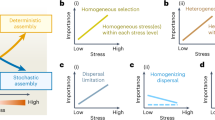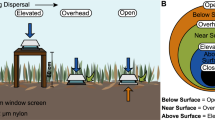Abstract
Stochastic processes can play an important role in microbial community assembly. Dispersal limitation is one process that can increase stochasticity and obscure relationships between environmental variables and microbial community composition, but the relationship between dispersal, selection and stochasticity has not been described in a comprehensive way. We examine how dispersal and its interactions with drift and selection alter the consistency with which microbial communities assemble using a realistic, individual-based model of microbial decomposers. Communities were assembled under different environmental conditions and dispersal rates in repeated simulations, and we examined the compositional difference among replicate communities colonizing the same type of leaf litter (‘within-group distance’), as well as between-group deterministic selection. Dispersal rates below 25% turnover per year resulted in high within-group distance among communities and no significant environmental effects. As dispersal limitation was alleviated, both within- and between-group distance decreased, but despite this homogenization, deterministic environmental effects remained significant. In addition to direct effects of dispersal rate, stochasticity of community composition was influenced by an interaction between dispersal and selection strength. Specifically, communities experiencing stronger selection (less favorable litter chemistries) were more stochastic, possibly because lower biomass and richness intensified drift or priority effects. Overall, we show that dispersal rate can significantly alter patterns of community composition. Partitioning the effects of dispersal, selection and drift based on static patterns of microbial composition will be difficult, if not impossible. Experiments will be required to tease apart these complex interactions between assembly processes shaping microbial communities.
Similar content being viewed by others
Log in or create a free account to read this content
Gain free access to this article, as well as selected content from this journal and more on nature.com
or
References
Adair EC, Parton WJ, Del Grosso SJ, Silver WL, Harmon ME, Hall SA et al. (2008). Simple three-pool model accurately describes patterns of long-term litter decomposition in diverse climates. Glob Chang Biol 14: 2636–2660.
Adams HE, Crump BC, Kling GW . (2014). Metacommunity dynamics of bacteria in an arctic lake: the impact of species sorting and mass effects on bacterial production and biogeography. Front Microbiol 5: 82.
Allison SD . (2012). A trait-based approach for modelling microbial litter decomposition. Ecol Lett 15: 1058–1070.
Allison SD . (2014). Modeling adaptation of carbon use efficiency in microbial communities. Front Microbiol 5: 571.
Allison SD, Chacon SS, German DP . (2014). Substrate concentration constraints on microbial decomposition. Soil Biol Biochem 79: 43–49.
Anderson MJ . (2001). Permutation tests for univariate or multivariate analysis of variance and regression. Can J Fish Aquat Sci 58: 626–639.
Anderson MJ . (2006). Distance-based tests for homogeneity of multivariate dispersions. Biometrics 62: 245–253.
Bell T . (2010). Experimental tests of the bacterial distance-decay relationship. ISME J 4: 1357–1365.
Bruns TD . (1995). Thoughts on the processes that maintain local species diversity of ectomycorrhizal fungi. Plant Soil 170: 63–73.
Chapin FS, Matson PA, Mooney HA . (2002) Principles of Terrestrial Ecosystem Ecology. Springer: New York, NY, USA.
Chase JM . (2007). Drought mediates the importance of stochastic community assembly. Proc Natl Acad Sci USA 104: 17430–17434.
Chase JM, Kraft NJB, Smith KG, Vellend M, Inouye BD . (2011). Using null models to disentangle variation in community dissimilarity from variation in α-diversity. Ecosphere 2: art24.
Chase JM, Myers JA . (2011). Disentangling the importance of ecological niches from stochastic processes across scales. Philos Trans R Soc Lond B Biol Sci 366: 2351–2363.
Crump BC, Adams HE, Hobbie JE, Kling GW . (2007). Biogeography of bacterioplankton in lakes and streams of an arctic tundra catchment. Ecology 88: 1365–1378.
Declerck SAJ, Winter C, Shurin JB, Suttle CA, Matthews B . (2013). Effects of patch connectivity and heterogeneity on metacommunity structure of planktonic bacteria and viruses. ISME J 7: 533–542.
Ferrenberg S, O’Neill SP, Knelman JE, Todd B, Duggan S, Bradley D et al. (2013). Changes in assembly processes in soil bacterial communities following a wildfire disturbance. ISME J 7: 1102–1111.
Fukami T . (2015). Historical contingency in community assembly: integrating niches, species pools, and priority effects. Annu Rev Ecol Evol Syst 46: 1–23.
Hanson CA, Fuhrman JA, Horner-Devine MC, Martiny JBH . (2012). Beyond biogeographic patterns: processes shaping the microbial landscape. Nat Rev Microbiol 10: 497–506.
Hubbel SP . (2001) The Unified Neutral Theory of Biodiversity and Biogeography. Princeton University Press: Princeton, NJ, USA.
Jones SE, McMahon KD . (2009). Species-sorting may explain an apparent minimal effect of immigration on freshwater bacterial community dynamics. Environ Microbiol 11: 905–913.
Leibold MA, Holyoak M, Mouquet N, Amarasekare P, Chase JM, Hoopes MF et al. (2004). The metacommunity concept: a framework for multi-scale community ecology. Ecol Lett 7: 601–613.
Levene H . (1960). Robust tests for equality of variances. In: Olkin I, Ghurye SG, Hoeffding W, Madow WG, Mann HB (eds), Contributions to Probability and Statistics: Essays in Honor of Harold Hotelling. Stanford University Press: Palo Alto, CA, USA, pp 278–292.
Lindström ES, Forslund M, Algesten G, Bergström A-K . (2006). External control of bacterial community structure in lakes. Limnol Oceanogr 51: 339–342.
Lindström ES, Östman Ö . (2011). The importance of dispersal for bacterial community composition and functioning. PLoS One 6: e25883.
Logue JB, Lindström ES . (2010). Species sorting affects bacterioplankton community composition as determined by 16S rDNA and 16S rRNA fingerprints. ISME J 4: 729–738.
Loreau M, Mouquet N . (1999). Immigration and the maintenance of local species diversity. Am Nat 154: 427–440.
Lowe WH, McPeek MA . (2014). Is dispersal neutral? Trends Ecol Evol 29: 444–450.
Martiny JBH . (2015). Dispersal and the microbiome. Microbe Mag 10: 191–196.
Martiny JBH, Bohannan BJM, Brown JH, Colwell RK, Fuhrman JA, Green JL et al. (2006). Microbial biogeography: putting microorganisms on the map. Nat Rev Microbiol 4: 102–112.
Matulich KL, Weihe C, Allison SD, Amend AS, Berlemont R, Goulden ML et al. (2015). Temporal variation overshadows the response of leaf litter microbial communities to simulated global change. ISME J 9: 2477–2489.
Mergeay J, De Meester L, Eggermont H, Verschuren D . (2011). Priority effects and species sorting in a long paleoecological record of repeated community assembly through time. Ecology 92: 2267–2275.
Mittelbach GG, Schemske DW . (2015). Ecological and evolutionary perspectives on community assembly. Trends Ecol Evol. 30: 241–247.
Mouquet N, Loreau M . (2002). Coexistence in metacommunities: the regional similarity hypothesis. Am Nat 159: 420–426.
Nemergut DR, Schmidt SK, Fukami T, O’Neill SP, Bilinski TM, Stanish LF et al. (2013). Patterns and processes of microbial community assembly. Microbiol Mol Biol Rev 77: 342–356.
Ofiteru ID, Lunn M, Curtis TP, Wells GF, Criddle CS, Francis CA et al. (2010). Combined niche and neutral effects in a microbial wastewater treatment community. Proc Natl Acad Sci USA 107: 15345–15350.
Oksanen J, Blanchett FG, Kindt R, Legendre P, Minchin PR, O’Hara RB et al. (2013). Vegan: Community Ecology Package. R package version 2.0-10.
Parton WJ, Schimel DS, Cole C V, Ojima DS . (1987). Analysis of factors controlling soil organic matter levels in great plains grasslands. Soil Sci Soc Am J 51: 1173–1179.
Paul EA, Clark F . (1997) Soil Microbiology and Biochemistry. Academic Press.
Peay KG, Garbelotto M, Bruns TD . (2010). Evidence of dispersal limitation in soil microorganisms: isolation reduces species richness on mycorrhizal tree islands. Ecology 91: 3631–3640.
Peay KG, Schubert MG, Nguyen NH, Bruns TD . (2012). Measuring ectomycorrhizal fungal dispersal: Macroecological patterns driven by microscopic propagules. Mol Ecol 21: 4122–4136.
R Core Team . (2013) R: a Language and Environment for Statistical Computing. R Foundation for Statistical Computing: Vienna, Austria.
Stegen JC, Lin X, Fredrickson JK, Chen X, Kennedy DW, Murray CJ et al. (2013). Quantifying community assembly processes and identifying features that impose them. ISME J 7: 2069–2079.
Stegen JC, Lin X, Fredrickson JK, Konopka AE . (2015). Estimating and mapping ecological processes influencing microbial community assembly. Front Microbiol 6: 370.
Steiner CF . (2014). Stochastic sequential dispersal and nutrient enrichment drive beta diversity in space and time. Ecology 95: 2603–2612.
Symons CC, Arnott SE . (2014). Timing is everything: priority effects alter community invasibility after disturbance. Ecol Evol 4: 397–407.
Van der Gucht K, Cottenie K, Muylaert K, Vloemans N, Cousin S, Declerck S et al. (2007). The power of species sorting: local factors drive bacterial community composition over a wide range of spatial scales. Proc Natl Acad Sci USA 104: 20404–20409.
Vanette RL, Marie-Pierre LG, Fukami T . (2014). Microbial community structure and function in floral nectar are shaped by variation in dispersalIn: Ecological Society of America Annual Meeting.
Vellend M . (2010). Conceptual synthesis in community ecology. Q Rev Biol 85: 183–206.
Vellend M, Srivastava DS, Anderson KM, Brown CD, Jankowski JE, Kleynhans EJ et al. (2014). Assessing the relative importance of neutral stochasticity in ecological communities. Oikos 123: 1420–1430.
Venail PA, MacLean RC, Bouvier T, Brockhurst MA, Hochberg ME, Mouquet N . (2008). Diversity and productivity peak at intermediate dispersal rate in evolving metacommunities. Nature 452: 210–214.
Zhou J, Liu W, Deng Y, Jiang YH, Xue K, He Z et al. (2013). Stochastic assembly leads to alternative communities with distinct functions in a bioreactor microbial community. MBio; e-pub ahead of print 5 March 2013; doi:10.1128/mBio.00584-12.
Acknowledgements
This manuscript is dedicated to the memory of Diana R Nemergut. This work was funded by the National Science Foundation Postdoctoral Research Fellowship in Biology (NSF DEB 1202882) to SE and the US Department of Energy, Office of Science, Office of Biological and Environmental Research (BER), under Award Number DE-PS02-09ER09-25 to SDA and JBHM. This is Kellogg Biological Station Contribution no. 1912. We also thank the Allison and Martiny labs at UC Irvine for helpful feedback, and Dylan Fitzpatrick for help with analysis. Finally, we thank Jenny Rocca, Gary Mittelbach, James Stegen, and one anonymous reviewer whose comments greatly improved the quality of this paper.
Author information
Authors and Affiliations
Corresponding author
Ethics declarations
Competing interests
The authors declare no conflict of interest.
Additional information
Supplementary Information accompanies this paper on The ISME Journal website
Supplementary information
Rights and permissions
About this article
Cite this article
Evans, S., Martiny, J. & Allison, S. Effects of dispersal and selection on stochastic assembly in microbial communities. ISME J 11, 176–185 (2017). https://doi.org/10.1038/ismej.2016.96
Received:
Revised:
Accepted:
Published:
Issue date:
DOI: https://doi.org/10.1038/ismej.2016.96
This article is cited by
-
Interrow cover crops in a semi-arid vineyard increase plant beneficial functional potential of the soil microbiome, both in vine rows and interrows, a benefit that increases with cover crop duration
Environmental Microbiome (2025)
-
Host selection is not a universal driver of phyllosphere community assembly among ecologically similar native New Zealand plant species
Microbiome (2025)
-
Increasing drying changes the relationship between biodiversity and ecosystem multifunctionality
npj Biofilms and Microbiomes (2025)
-
Glacier-fed lakes produce lower methane fluxes than non-glacier-fed lakes on the Tibetan Plateau
Communications Earth & Environment (2025)
-
Unveiling the ecological processes driving soil and lichen microbiome assembly along an urbanization gradient
npj Biofilms and Microbiomes (2025)



